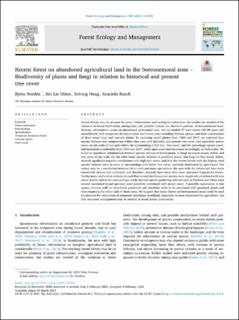Recent forest on abandoned agricultural land in the boreonemoral zone – Biodiversity of plants and fungi in relation to historical and present tree cover
Peer reviewed, Journal article
Published version

Åpne
Permanent lenke
https://hdl.handle.net/11250/2734231Utgivelsesdato
2021Metadata
Vis full innførselSamlinger
- Publikasjoner fra CRIStin - NINA [2364]
- Scientific publications [1392]
Originalversjon
10.1016/j.foreco.2021.119045Sammendrag
Recent forests may be an asset for green infrastructure and ecological restoration, but studies are needed of the variation in forest biodiversity among sites, and possible reasons for observed patterns. In boreonemoral Scandinavia, reforestation occurs on abandoned agricultural land, and we studied 27 such recent (40–80 years old) mixed forests with temperate deciduous trees and boreal trees including Norway spruce, and their communities of dead wood fungi and vascular plants. By analysing aerial photos from 1960 and 2017, we explored how species richness and composition within sites vary with historical and present tree cover, and separately spruce cover, at site scale (2 ha) and within the surroundings (12.5 ha). Tree cover, and the percentage spruce cover, had increased considerably from 1960 and 2017, while open areas had decreased accordingly, at both scales. We found no significant relationships between species richness of forest plants, or fungi on coarse woody debris, and tree cover at any scale. On the other hand, species richness of grassland plants, and fungi on fine woody debris, showed significant negative correlations with high tree cover, and thus the recent forests with the highest total species richness seem to occur in surroundings with lower tree cover, currently dominated by agriculture. The reason may be a correlation between richer soils and more agriculture; the area with the richest soil have been extensively cleared and cultivated, and therefore currently have lower tree cover and more fragmented forests. Furthermore, ordination analysis showed that several deciduous tree species were negatively correlated with tree cover, locally and in the surroundings, while the tree species preferring rich soil such as Fraxinus and Ulmus (and several associated fungal species), were positively correlated with spruce cover. A possible explanation is that spruce colonize well on abandoned grasslands and therefore tends to be associated with grassland plants and trees requiring the richer soils of these areas. We suggest that recent forests in boreonemoral areas could be used for instance for restoration of temperate deciduous woodland, especially in areas dominated by agriculture, but that recurrent management may be needed to avoid spruce domination. Forest restoration Reforestation Sprucification Temperate deciduous forest Vascular plants Dead wood
